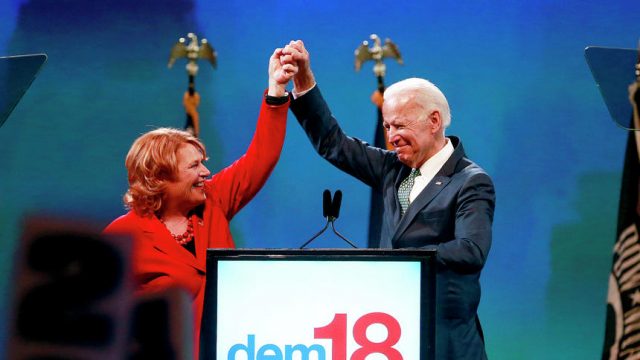Democrats Have Created a Situation Where Good Trade News for America Is Bad Political News for Them

Senator Heidi Heitkamp and former Vice-President Joe Biden raise arms in unity at the North Dakota Democratic convention Saturday in Grand Forks. photo by Eric Hylden/Grand Forks Herald
Last month Democratic Senator Heidi Heitkamp predicted that President Donald Trump’s “drastic trade policies would instead come back to hit American farmers and ranchers where it hurts.”
“I urge the administration to rethink its unwise actions on trade before irreparable damage is done,” Mac Schneider, Democratic candidate for the U.S. House, said.
The politics of this positioning is obvious. Both Heitkamp and Schneider hope to get re-elected/elected in a farm state where rural voters cast their ballots overwhelmingly for President Trump. Their political party, meanwhile, hates Trump with the power of a thousand suns. They’re hoping they can appeal to their left wing base of voters by beating up on Trump while simultaneously can convincing rural and agriculture-connected voters that Trump’s policies are bad for them.
Put simply, the candidates are looking to position themselves as anti-Trump in a way that works in Trump country.
But what this also does is put Heitkamp and Schneider in a position where good news on trade is bad news for them.
Case in point, despite the dire warnings coming from Schneider and Heitkamp, President Trump announced this morning an agreement with China which could increase agriculture exports to that country:
China has agreed to buy massive amounts of ADDITIONAL Farm/Agricultural Products – would be one of the best things to happen to our farmers in many years!
— Donald J. Trump (@realDonaldTrump) May 21, 2018
The usual caveats having to do with Trumpian excesses in rhetoric apply here, of course. We’re a long way off from anything looking like an official deal with China. But this would seem to end the threat of a trade war for now.
The possibility for a positive outcome from Trump’s aggressive maneuvering with China is very real. And Democrats like Schneider and Heitkamp have positioned themselves in a way where a positive outcome on trade for America (including for American ag producers) is a political negative for them.
This gambit might not play out well for them.
Meanwhile, much has been made about declining soybeans prices, mostly because of the trade politics surrounding them, but commodity trader Eugene Graner of Heartland Investor Services in Bismarck makes the case that the recent declines are routine and seasonal in nature.
He sends this chart:
“I want you to notice the two purple lines, and the one to the left reflecting the 2017 decline. 2017 was a classic seasonal price movement year for beans, as soybeans typically peak out on their winter rally by March and then seasonally decline into the end of June/early July when weather scares start to show up,” Graner told me via email. “2017 peaked around the same time and is scheduled for a normal seasonal decline now into June. Granted various years have little intrinsic differences by month or so, but in the end, this is a typical seasonal decline.”





